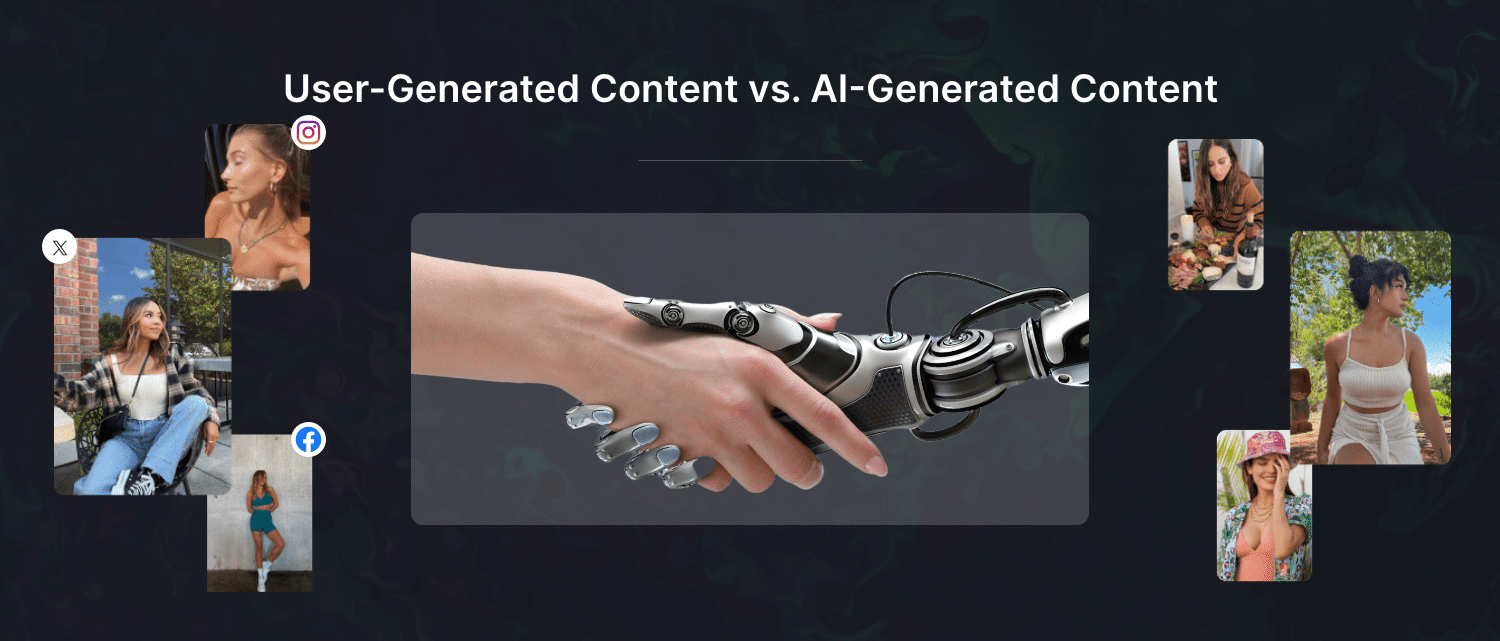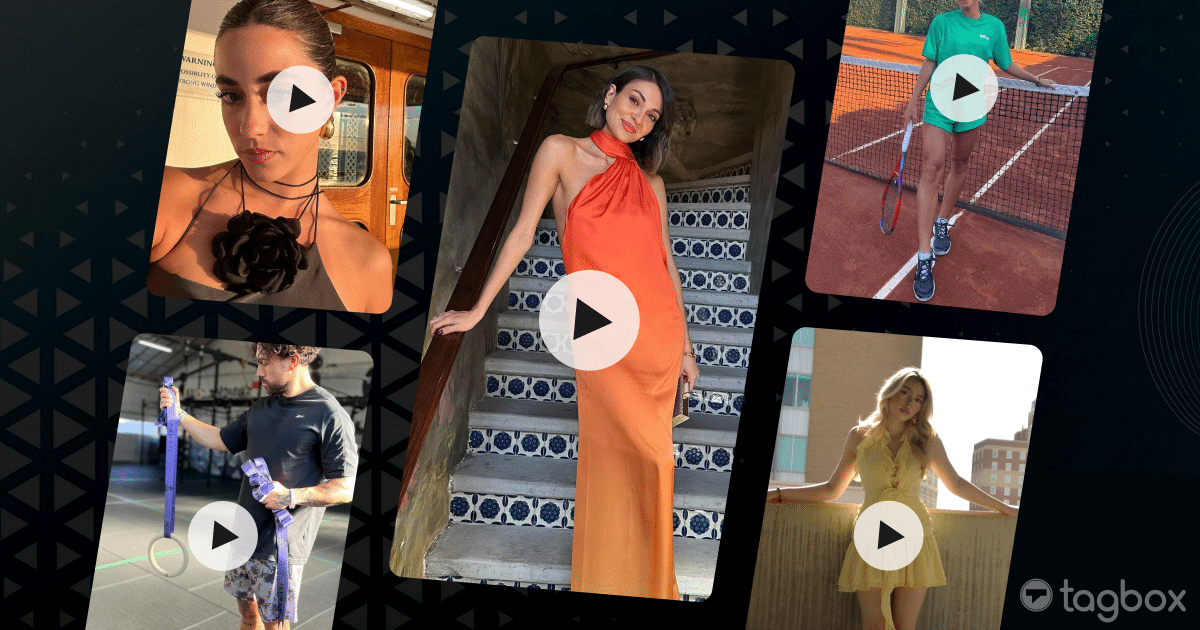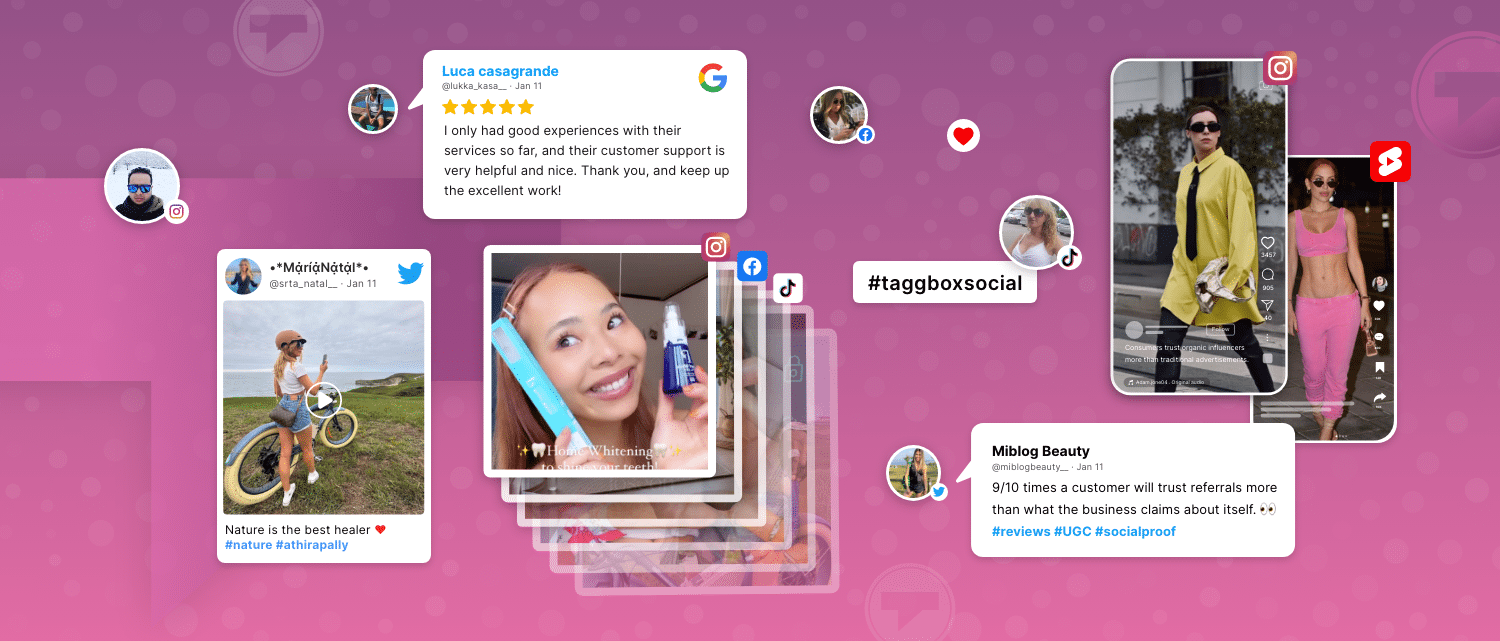User-Generated Content vs. AI-Generated Content: The Death of an Era
AI, ChatGPT, Generative AI, Midjourney, and the whole AI gang—these have been the hot topics of the year, and yet it seems like they’re just getting started. This sudden rise of AI has prompted a single question to our minds: “Will AI replace everything in the future?” Let’s end this debate of User-generated content vs. AI-generated content once and for all. I have conducted in-depth research and held conversations with experts to conclude that we will discuss further. Till then, here’s a little spoiler:
Before we jump into the question, let’s take a moment to understand what our customers want from us as a brand. Quality products and services? Absolutely. Value for money?
User-generated Content vs. AI-Generated Content
No doubt. But there’s more to it. Interestingly, according to Stackle, “Consumers find User Generated Content 9.8x more impactful than influencer content when making a purchasing decision.” With this, it’s safe to say that our customers are looking for authenticity, reliability, and building a relationship with us, and that they love UGC.
Let’s compare both sides —User-Generated Content vs. AI-Generated Content —without bias and see what works.
| Aspect | User-Generated Content (UGC) | AI-Generated Content |
| Source | Created by real users | Created by artificial intelligence |
| Authenticity | Genuine and based on real experiences | Lacks the authentic touch of human emotions |
| Diversity | Offers a wide range of perspectives | May lack personal nuances and creativity |
| Creativity | Reflects individual creativity and style | Lacks the creativity of human expression |
| Connection | Establishes a deeper emotional connection | Lacks the emotional depth of human touch |
| Community Building | Fosters a sense of community and belonging | Lacks the ability to engage with communities |
| Trust | Builds trust through peer recommendations | May be perceived as impersonal or biased |
| Engagement | Encourages active participation and feedback | May not evoke the same level of engagement |
| Relevance | Tackles real-world issues and concerns | May lack understanding of current context |
| Virality | Can go viral organically through sharing | May not have the same viral potential |
| Adaptability | Adapts to trends and rapidly changing topics | May require frequent updates and revisions |
| Legal & Ethical Concerns | May need moderation, but promotes user freedom | May raise ethical concerns about AI’s usage |
| Cost | Cost-effective, leveraging user contributions | Involves development and maintenance costs |
User-Generated Content (UGC)
User-generated content refers to any content, such as text, pictures, videos, or reviews, that users create and post on social media based on their experiences with a brand.
Now these brands are smart enough to use these assets and republish them on their marketing channels. This has helped them boost their sales significantly because, as mentioned earlier, users value authenticity, and UGC embodies it perfectly.
These brands are none other than our favorites, such as GoPro, Airbnb, Starbucks, Apple, Nike, and a host of other top-notch players.

UGC is not limited to authenticity; it offers a lot more and numerous advantages.
Advantages of User-Generated Content
1. Authenticity and Trustworthiness:
Of course, authenticity must be the priority. Unlike traditional marketing content, which often feels promotional, user-generated content is generated by real people with genuine experiences and opinions. This authenticity fosters trust among audiences, as they see UGC as unbiased and honest reviews or recommendations from their peers. When potential customers see positive UGC videos about a product or service, they are more likely to trust and engage with the brand.
2. Cost-Effective Marketing:
For businesses, user-generated content (UGC) presents a cost-effective marketing strategy. Instead of investing significant resources in creating polished marketing materials, brands can leverage content that their satisfied customers or followers created. User-generated content is essentially free advertising, as customers willingly share their experiences on social media, review sites, and blogs, expanding the brand’s reach without the need for paid campaigns.
3. Increased Engagement:
UGC encourages customer engagement. When individuals see their content being shared or featured by a brand, they feel a sense of recognition and validation. This fosters a stronger connection between the brand and its customers, leading to increased brand loyalty. Moreover, user-generated content often sparks conversations and discussions, resulting in higher levels of engagement within the online community.
4. Diverse Perspectives and Creativity:
UGC provides a diverse range of perspectives, ideas, and creativity. As people from different backgrounds and experiences generate content, it brings a fresh and authentic viewpoint to the table. Utilizing tools like an Ai image generator can further enhance the appeal and engagement of user-generated content. This variety not only enriches the overall content pool but also enables brands to understand their audience’s needs and preferences better.
5. Valuable Feedback and Insights:
For businesses, user-generated content can be a valuable source of feedback and insights. Customers often share their opinions, suggestions, and experiences with products or services, enabling companies to identify areas of improvement and make informed decisions. Analyzing UGC patterns can also help businesses identify trends and consumer preferences, enabling them to adapt their strategies accordingly.
6. Community Building:
UGC plays a pivotal role in community building. By encouraging customers to share their stories and experiences, brands create a sense of belonging and trust among their followers. An active and engaged community fosters brand advocacy, with customers becoming brand ambassadors who spread positive word-of-mouth and attract new customers.
7. Viral Potential:
Finally, UGC has exceptional viral potential. An impactful UGC campaign can quickly gain momentum, spreading across social media platforms and garnering immense exposure. The power of UGC lies in its shareability, making it an ideal tool for brands seeking to reach a broader audience organically.
Limitations of UGC
1. Quality Control:
UGC is diverse, ranging from insightful and well-crafted content to irrelevant or even harmful material. Maintaining quality standards amidst the vast amount of UGC can be a daunting task. Implementing strict content guidelines, encouraging constructive feedback, and utilizing automated tools for content moderation are essential steps to ensure that only relevant and valuable content is shared.
2. Brand Reputation:
Since users generate UGC, businesses can’t entirely control the message conveyed. Adverse or misleading UGC can potentially harm a brand’s reputation. To mitigate this risk, actively monitor user content, respond promptly to negative feedback, and address any issues with transparency and empathy. Building strong relationships with customers can help in managing brand perception amidst UGC challenges.
3. Legal and Copyright Issues:
Sharing copyrighted content or infringing on intellectual property rights is a significant concern associated with user-generated content (UGC). Platforms and businesses must have clear terms of use, copyright policies, and disclaimers to protect themselves from potential legal repercussions. Educating users about copyright laws and encouraging original content creation can also help mitigate these issues.
However, the good news is that Tagbox offers the perfect solution! With their content moderation and UGC Rights tool, all these limitations can be eliminated, and you can run a smooth UGC campaign.
AI-Generated Content
AI-generated UGC refers to content, such as text, images, videos, or music, that is created using artificial intelligence (AI) algorithms and techniques. Learning how to create AI-generated videos is becoming an essential skill, enabling creators to produce innovative and engaging content with ease.
Instead of being authored by humans, AI-generated content is generated by machines based on patterns, data, and models learned during training. However, to make the use of the best AI video generator successful, a robust data annotation process is essential to achieve professional results.
People are killing it when it comes to generative AI or AI-generated content, for instance, have you heard of the upcoming movie, The Great Catsby? Yeah, you read it right. It’s a trailer for a non-existent masterpiece created by AI, and it’s hilarious. Have a look.
This is not it, people are going crazy with ChatGPT as well, it’s not just being used for homework or writing Instagram captions, here is an innovative twist:
Jokes aside, ChatGPT has a lot more scope than this, and brands are also using it for their marketing efforts. However, with so many tools emerging, many marketers are now exploring the best ChatGPT alternatives to diversify their AI content strategies. Let’s examine the advantages and limitations of AI-generated content.
Advantages of AI-Generated Content
1. Unparalleled Efficiency:
One of the most significant advantages of AI-generated content is its unmatched efficiency. Large Language Models (LLMs) can swiftly generate vast amounts of content, saving time and effort for content creators. This efficiency is particularly valuable for businesses and marketers who need to produce large volumes of content for various platforms and diverse audiences.
2. Consistency and Scalability:
AI-generated content ensures a high level of consistency and scalability. Once an AI model is trained, it can produce consistent and uniform content, maintaining the brand’s tone and style across various channels. This scalability enables businesses to reach broader audiences without compromising on content quality.
3. Personalization at Scale:
Personalization is crucial for engaging modern audiences. AI-generated content can analyze user data and preferences to create tailored content for each individual, especially when enhanced with an AI humanizer.
By offering personalized experiences at scale, brands can build stronger connections with their audience and improve customer engagement.
4. Creativity and Novelty:
Contrary to concerns that AI will replace human creativity, AI-generated content has demonstrated impressive creativity and novelty. AI models can synthesize patterns from vast datasets and generate unique and innovative content ideas that humans might not have considered, enriching the creative process.
5. Multilingual Content:
With AI-powered language models, creating multilingual content has become more accessible. AI-generated content can be effortlessly translated using an AI translator to adapt to various languages, enabling businesses to reach global audiences and expand their international presence.
Tools like a TMS (Translation Management System) can enhance the AI translation process. This system further accelerates translation, centralizes tasks, manages linguistic resources, and ensures consistency across all translated content.
6. Data-Driven Insights:
AI-generated content relies on data analysis, which offers valuable insights into audience behavior and preferences. By leveraging these insights, content creators can refine their strategies, optimize content performance, and tailor content to meet specific audience needs.
7. Real-Time Content Generation:
Real-time content is crucial to staying relevant in rapidly changing environments. AI-generated content can rapidly respond to trends and deliver real-time updates, enhancing a brand’s agility and adaptability.
8. Cost-Effective Solutions:
AI-generated content can be a cost-effective alternative to hiring and managing a large content creation team, such as that generated by ChatGPT alternatives. By leveraging AI tools, businesses can streamline content production, reducing operational costs and enhancing overall return on investment (ROI).
The Art of Balancing User-generated Content vs. AI-Generated Content:

The art of balancing User-Generated content vs. AI-Generated Content lies in leveraging the strengths of each approach to create compelling and impactful content.
Embrace UGC’s authenticity and community-building power without worrying about its limitations, as Tagbox can easily address them while harnessing the efficiency, scalability, and creativity of AI-generated content.
As technology evolves, content creators must stay adaptable and innovative, finding the sweet spot where UGC and AI work harmoniously to deliver valuable experiences to their audience.
Striking this balance is key to creating content that engages and establishes meaningful, lasting connections with users.
FAQs
The problem with AI-generated content lies in its potential lack of human creativity, empathy, and understanding of nuanced context. It may produce content that lacks authenticity and emotional connection, and there's a risk of misinformation and bias based on the data it learns from. Additionally, AI-generated content can raise ethical concerns about authorship and copyright issues.
AI-generated content can have both positive and negative impacts on SEO. It can improve efficiency and keyword optimization but may lack authenticity and struggle with context. Balancing it with human-created content is crucial for SEO success.
UGC is preferred over AI-generated content due to its authenticity, emotional connection, community building, diverse perspectives, cost-effectiveness, legal considerations, and adaptability to trends.






